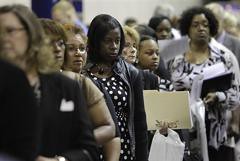
In this Aug. 25, 2010 photograph, job seekers including Lindsey Wright, of Detroit, center, attend a job fair in Southfield, Mich. On Friday, Sept. 3, 2010, the Labor Department issued the August unemployment report. (AP Photo/Paul Sancy), a photo by Pan-African News Wire File Photos on Flickr.
Why Is U.S. Work Force Shrinking?
The labor force participation rate in the U.S. fell in August to the lowest level since 1978, a development that may reflect the lack of higher-paying jobs in the economy.
By Eric Morath
The labor force participation rate in the U.S. fell in August to the lowest level since 1978, a development that may reflect the lack of higher-paying jobs in the economy.
Participation in the workforce has trended down steadily since early 2008, near the start of the recession, and fell last month to 63.2%.
A number of factors are driving the trend, including an aging population, women no longer entering the labor force at increasing rates and a growing fraction of those with college educations not working.
People in all those groups may not be able to find jobs that pay enough to entice them to work rather than pursue other options, be it early retirement, raising children or returning to school.
“At the margin, people are saying the reward is not worth the effort, and focusing on other things,” said John Silvia, chief economist at Wells Fargo.
The biggest long-term driver of the downward trend is women’s participation. From World War II until the early 2000s, the fraction of women working grew steadily. Then the rate leveled off, but didn’t begin to fall significantly until after the recession ended in June 2009.
Since then, the participation rate among women has fallen more than two percentage points to 57.3% last month—on par with the rate in the early 1990s.
Lower-wage earners in two-income households, whether men or women, may find that a job in a restaurant or retail store — two growing areas of employment — doesn’t compensate for the cost of childcare or time away from family.
The participation rate among men fell in August to the lowest levels on records back to 1948, continuing a downward trend that accelerated during the recession.
One concerning development is that even well-educated people are dropping from the labor force. The participation rate among people with bachelor’s degrees fell by more than a percentage point from a year ago. In contrast, the rates for those without high-school diplomas, while much lower, held nearly steady in the past year.
No comments:
Post a Comment